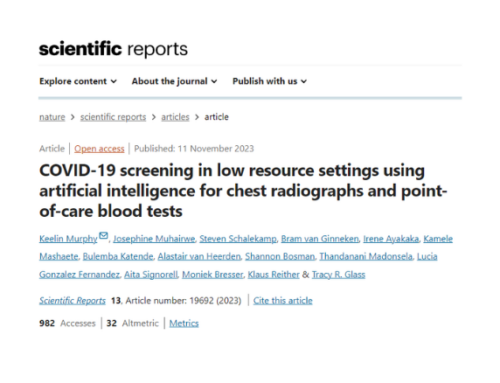Incidental radiological findings during clinical tuberculosis screening in Lesotho and South Africa: a case series
🔗2023
🔗Journal/Publication: Journal of Medical Case Reports
🔗Read it in full version: https://doi.org/10.1186/s13256-023-04097-4
Abstract
Background
Chest X-ray offers high sensitivity and acceptable specificity as a tuberculosis screening tool, but in areas with a high burden of tuberculosis, there is often a lack of radiological expertise to interpret chest X-ray. Computer-aided detection systems based on artificial intelligence are therefore increasingly used to screen for tuberculosis-related abnormalities on digital chest radiographies. The CAD4TB software has previously been shown to demonstrate high sensitivity for chest X-ray tuberculosis-related abnormalities, but it is not yet calibrated for the detection of non-tuberculosis abnormalities. When screening for tuberculosis, users of computer-aided detection need to be aware that other chest pathologies are likely to be as prevalent as, or more prevalent than, active tuberculosis. However, non-tuberculosis chest X-ray abnormalities detected during chest X-ray screening for tuberculosis remain poorly characterized in the sub-Saharan African setting, with only minimal literature.
Case presentation
In this case series, we report on four cases with non-tuberculosis abnormalities detected on CXR in TB TRIAGE + ACCURACY (ClinicalTrials.gov Identifier: NCT04666311), a study in adult presumptive tuberculosis cases at health facilities in Lesotho and South Africa to determine the diagnostic accuracy of two potential tuberculosis triage tests: computer-aided detection (CAD4TB v7, Delft, the Netherlands) and C-reactive protein (Alere Afinion, USA). The four Black African participants presented with the following chest X-ray abnormalities: a 59-year-old woman with pulmonary arteriovenous malformation, a 28-year-old man with pneumothorax, a 20-year-old man with massive bronchiectasis, and a 47-year-old woman with aspergilloma.
Conclusions
Solely using chest X-ray computer-aided detection systems based on artificial intelligence as a tuberculosis screening strategy in sub-Saharan Africa comes with benefits, but also risks. Due to the limitation of CAD4TB for non-tuberculosis-abnormality identification, the computer-aided detection software may miss significant chest X-ray abnormalities that require treatment, as exemplified in our four cases. Increased data collection, characterization of non-tuberculosis anomalies and research on the implications of these diseases for individuals and health systems in sub-Saharan Africa is needed to help improve existing artificial intelligence software programs and their use in countries with high tuberculosis burden.


